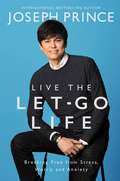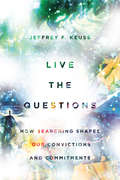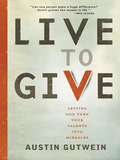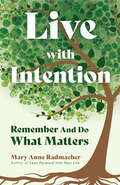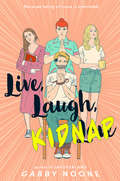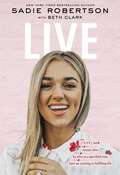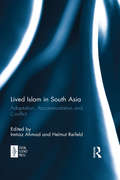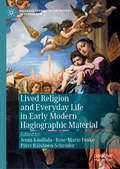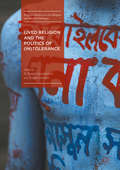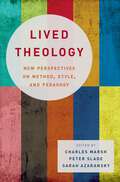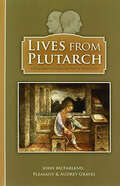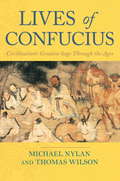- Table View
- List View
Live the Let-Go Life: Breaking Free from Stress, Worry, and Anxiety
by Joseph PrinceAre You Overwhelmed by Stress, Worry, and Anxiety?Unending daily to-do lists. The frantic pace of modern living. The race to stay relevant in the face of disruption. The very real threat of superbugs and terror in our everyday lives... It's not hard to see why so many people today are experiencing stress, worry, and anxiety attacks.Unfortunately, these aren't simply innocent states of emotion-they can insidiously develop into chronic depression and psychosomatic illnesses, and lead to destructive behaviors. But here's the good news: While stress is depleting and debilitating, it can be defeated and driven from your life.In LIVE THE LET-GO LIFE, Joseph Prince shows you how to beat stress and anxieties that come with the everyday demands and pressures of modern living. Discover how you were not designed by God to live under stress, but called to live the life of rest. You will learn how to let go of stress and see His grace flow unabated in the worry-free areas of your life.
Live the Life
by Craig Borlase Mike PilavachiHow can we deal with temptation and guilt? Can we hear God speak? How can we share our faith?How do we know what to do with our lives? LIVE THE LIFE doesn't pretend that being a Christian is easy, but points the way to a walk with God that impacts the whole of our lives. This is Mike's story about getting through life, keeping Jesus at the centre and living life to the full!
Live the Questions: How Searching Shapes Our Convictions and Commitments
by Jeffrey F. Keuss"Live the questions now. Perhaps you will then gradually, without noticing it, live along some distant day into the answer." —Rainer Maria Rilke Life is full of questions: questions about our identity, our relationships, our faith. Sometimes it seems like there are no easy answers. But our questioning can lead us on a journey into greater understanding and purpose. Jeffrey Keuss says that asking good questions helps us to lead good lives. He takes us on a tour of Scripture to find insights from people who asked questions of God and others. From God asking Adam and Eve, "Where are you?" to the Samaritan woman asking Jesus for water, Live the Questions explores critical questions in Scripture and what they can teach us about doubt, faith, and uncertainty in our everyday lives. Grappling with hard questions is necessary for us to form deeper faith commitments and discern who we are called to become. So don't be afraid of the questions—live them.
Live to Give
by Austin GutweinWant to do something for God but don't know what? Want to help others but don't know who? Want to know what it is you're really good at doing? Your gifts may feel small and insignificant. But God can use them to work a miracle! Inspired by the biblical story of the feeding of the 5,000, Live to Give delivers a message of hope that we all have something to give. Written in the down-to-earth, candid voice of the gifted young man who as a kid founded a relief ministry that has saved and improved countless lives in Africa, Live to Give is the message that every teen needs to hear: You are more special than you know, and you can do big things. Jesus proved that no gift is too small when He used five loaves and two fish to feed a crowd of thousands. And if no gift is too small, too ordinary, or too random, there is no limit to what the youth of today can accomplish! A teenage philanthropist who has built a high school, two medical clinics, and a dormitory in Africa--all before the age of 16--Austin Gutwein shares how to take what may seem like the simplest of talents, gifts, and interests and use them for something Jesus can use to move mountains.Meets national education standards.
Live to Make A Difference
by Max LucadoFeaturing key selections from Outlive Your Life, this booklet embodies the spirit of making a difference in the church as well as the local community, region, and world. Perfect for giving away to your church community, small group, or neighbors.
Live with Intention: Remember And Do What Matters
by Mary Anne Radmacher“A book of beauty, creativity, wisdom, and great good will. Her chapter on forgiveness alone is worth the price of the book.” —Hugo Prather, bestselling author of Notes to MyselfMary Anne Radmacher is among the most-quoted women writers of our day. Her wisdom is found on greeting cards, journals, calendars, Instagram and Pinterest, in broadcast news, sermons, ceremonies and commencement speeches.This noted author, artist and teacher lost a dear one. As memorial to her friend her book became the manifesto for an intentional life for thousands of people. In Live with Intention, Radmacher shares the story of how she learned to live more robustly by watching how her courageous friend chose to die. People who keep Radmacher’s writings at the ready, say this writing is both inspiring and comforting. Extraordinary lessons are drawn from ordinary experiences. Rich in story, metaphor and poetry, Live with Intention explores with you what it means to live each day with purposeful intent:Understand what matters most for youDeepen what already makes your life richDetermine your unique way to make a difference“Live with Intention is a pure gift . . . Pick up this gem and bask in insight after insight.” —David Kundtz, author of The Art of Stopping“Live with Intention gives us the tools to believe we can go after dreams and actually capture them.” —Pat Ballard, author of 10 Steps to Loving Your Body (No Matter What Size You Are)“Beautiful, artistic, inspiring, and written from her heart.” —Dr. Patrick Williams, coauthor of Becoming a Professional Life Coach
Live, Laugh, Kidnap
by Gabby NooneFrom the author of Layoverland comes another bitingly clever, laugh-out-loud funny novel, about a group of teen girls going up against an exploitative megachurch in their small Montana town.The only thing Genesis, Holly and Zoe seem to have in common is being stuck in Violet, Montana. Well, that and the fact that Hope Harvest Ministries is trying to ruin their lives. Genesis lives on a commune that is now an echo of the New Age cult it once was. She&’s witnessed power couple Pastor Jay and Ree Reaps transform their sleepy small town into a haven for online Influencers, who flock to Violet, Bible in one hand and Ree&’s bestselling ACT LIKE A LADY, PRAY LIKE A BOSS in the other. Now, the Reaps have decided it&’s God&’s Will™ that they take over Gen&’s ranch. Holly is a begrudging tourist, forced to spend the summer with her estranged father as punishment for her unsavory behavior back in LA. To Holly, Hope Harvest is nothing but a gimmicky marketing ploy, but it&’s threatening to put her father&’s diner out of business and, for some reason, Holly cares. All Zoe wants is to leave Violet, working thankless shifts at the diner to scrape together enough cash to start a new life with her girlfriend. But Zoe&’s mother has lost everything to the church&’s multilevel marketing schemes so the little money that Zoe manages to make goes right to debt collectors. The only solution to their problems is to scam the scammers and protect what&’s theirs. It shouldn&’t take much – the Reaps&’ golden son, an accidental kidnapping, some light blackmail – and the Reaps&’ fortune will be in the girls&’ much more deserving hands. As long as everything goes according to plan…
Live, Love, Lead
by Brian HoustonWhether you are searching for your calling or wholeheartedly pursuing your life's purpose, Brian Houston's transformative approach to life will help you navigate a faith path that is all your own and discover unique gifts tailored perfectly for your journey. Thirty-five years ago when Brian Houston set out to pioneer a church with thirty people in a school hall, he had no idea how many highs and lows, sacrifices and miraculous opportunities he would face. Over time, his tiny church grew into the worldwide Hillsong ministry, leading people all over the globe to follow the greatest Guide who ever walked the path of life - Jesus. In this straightforward book, Brian Houston shares his own life-tested experiences and the powerful biblical truths he's learned that will enable you to live fully, love completely, and lead boldly - the hallmarks of Jesus' time on earth. When it comes to life with Jesus, there is no doubt - your best is yet to come! 'This is a remarkable book by a remarkable man. You will love his transparency and passion!'Rick Warren, founder and pastor of Saddleback Church, author of bestseller The Purpose Driven LifeBRIAN HOUSTON is the founder and Senior Pastor of Hillsong Church. With global campuses around the world, including New York and Los Angeles, Hillsong has a combined weekly attendance of over 90,000. Houston hosts one of the fastest growing daily international broadcasts in the world. He is also Executive Director for Hillsong Music, one of the world's largest producers of Christian music. He and his wife Bobbie have three grown children and live in Sydney, Australia and Orange County, California.(P)2015 Hachette Audio
Live, Love, Lead: Your Best Is Yet To Come!
by Brian HoustonWhether you are searching for your calling or wholeheartedly pursuing your life's purpose, Brian Houston's transformative approach to life will help you navigate a faith path that is all your own and discover unique gifts tailored perfectly for your journey. Thirty-five years ago when Brian Houston set out to pioneer a church with thirty people in a school hall, he had no idea how many highs and lows, sacrifices and miraculous opportunities he would face. Over time, his tiny church grew into the worldwide Hillsong ministry, leading people all over the globe to follow the greatest Guide who ever walked the path of life - Jesus. In this straightforward book, Brian Houston shares his own life-tested experiences and the powerful biblical truths he's learned that will enable you to live fully, love completely, and lead boldly - the hallmarks of Jesus' time on earth. When it comes to life with Jesus, there is no doubt - your best is yet to come! 'This is a remarkable book by a remarkable man. You will love his transparency and passion!'Rick Warren, founder and pastor of Saddleback Church, author of bestseller The Purpose Driven LifeBRIAN HOUSTON is the founder and Senior Pastor of Hillsong Church. With global campuses around the world, including New York and Los Angeles, Hillsong has a combined weekly attendance of over 90,000. Houston hosts one of the fastest growing daily international broadcasts in the world. He is also Executive Director for Hillsong Music, one of the world's largest producers of Christian music. He and his wife Bobbie have three grown children and live in Sydney, Australia and Orange County, California.
Live: remain alive, be alive at a specified time, have an exciting or fulfilling life
by Sadie RobertsonLive, the newest book from New York Times bestselling author and popular social media presence Sadie Robertson, addresses life's weightiest matters and choices in fun, practical, and biblical ways and leads readers to engage with God's truth and light in a world that is growing more and more confusing. There's a big difference between being alive and knowing how to truly live. To be alive is something that happens to you. But to truly live is something you get to choose each day. As Robertson says, "When you truly learn to live the life God offers, your whole existence becomes a verb."In Live, Sadie Robertson inspires us to thrive in the life God gave us by making choices that will lead us into the fullness He has for us, not into the emptiness the world offers. With photography and captivating design, Live shows us how we can find a rich and rewarding life when we choose to wholeheartedly embrace God's ways and God's truth. Moments of decision greet everyone, sometimes on a more-than-daily basis. Some of those decisions are minor and others are life altering, but all serve as stepping-stones to peace, joy, and fullness or to disappointment and emptiness. Sadie is passionate about inspiring a generation to live in that fullness every day.The book includes material on overcoming jealousy, finding confidence, dealing with haters, waiting on God, living in the moment, discovering the power of words, and knowing how to tell the difference between what leads to life and what leads to death--so young people can make the best choices.Whether you have a long-time relationship with God or are new to faith, Live is a joyful encouragement to make the most of each moment, to make wise decisions, and to always seek the truth of God's Word. Filled with stories and biblical principles, Live celebrates what everyone has in common--the opportunity to not simply be alive but to truly live.
Lived Islam in South Asia: Adaptation, Accommodation and Conflict (Berghahn Ser.)
by Imtiaz Ahmad and Helmut ReifeldSouth Asia is probably the largest area in the world where Islam exists within a mixed composite culture, overlapping with several other religions. No matter how many origins of political conflicts one may find in the domain of culture and religion, there are, at the same time, elements of peaceful co-existence as well.
Lived Islam: Colloquial Religion In A Cosmopolitan Tradition
by A. Kevin ReinhartDoes Islam make people violent? Does Islam make people peaceful? In this book, A. Kevin Reinhart demonstrates that such questions are misleading, because they assume that Islam is a monolithic essence and that Muslims are made the way they are by this monolith. He argues that Islam, like all religions, is complex and thus best understood through analogy with language: Islam has dialects, a set of features shared with other versions of Islam. <P><P> It also has cosmopolitan elites who prescribe how Islam ought to be, even though these experts, depending on where they practice the religion, unconsciously reflect their own local dialects. Reinhart defines the distinctive features of Islam and investigates how modernity has created new conditions for the religion. Analyzing the similarities and differences between modern and pre-modern Islam, he clarifies the new and old in the religion as it is lived in the contemporary world.
Lived Religion and Everyday Life in Early Modern Hagiographic Material (Palgrave Studies in the History of Experience)
by Jenni Kuuliala Rose-Marie Peake Päivi Räisänen-SchröderThis book discusses the ways in which early modern hagiographic sources can be used to study lived religion and everyday life from the fifteenth to the seventeenth century. For several decades, saints’ lives, other spiritual biographies, miracle narratives, canonisation processes, iconography, and dramas, have been widely utilised in studies on medieval religious practices and social history. This fruitful material has however been overlooked in studies of the early modern period, despite the fact that it witnessed an unprecedented growth in the volume of hagiographic material. The contributors to this volume address this, and illuminate how early modern hagiographic material can be used for the study of topics such as religious life, the social history of medicine, survival strategies, domestic violence, and the religious experience of slaves.
Lived Religion and the Politics of (In)Tolerance
by R. Ruard Ganzevoort Srdjan SremacThis volume explores the ways in which lived religion encourages and contributes to conflicts, as well as fosters tolerance, in the interlocking rural, urban, and virtual social spheres. Through ten case studies with vast geographical and religious variation, the contributors address some of the shortcomings in analyses of the relationship between religion and (in)tolerance and offers a theoretically and empirically more nuanced understanding of the micro-politics of (in)tolerance and the roles of lived religion in it. The book argues that (in)tolerance and its connection to religion cannot be fully understood unless analyzed from below, which means that the focus needs to be not only on public institutions or religio-political spaces but also on (in)tolerance of ordinary people and their performativity, practices, and interests in non-institutionalized spaces. This showcases the ambiguous interconnectedness of lived religion and (in)tolerance. Lived Religion and the Politics of (In)Tolerance will be of interest to students and scholars interested in lived religion, the relationship between politics and religion, and those working in cross-cultural dialogue and through an anti-racism, and anti-violence lens.
Lived Religion in America: Toward a History of Practice
by David D. HallAt once historically and theoretically informed, these essays invite the reader to think of religion dynamically, reconsidering American religious history in terms of practices that are linked to specific social contexts. The point of departure is the concept of "lived religion." Discussing such topics as gift exchange, cremation, hymn-singing, and women's spirituality, a group of leading sociologists and historians of religion explore the many facets of how people carry out their religious beliefs on a daily basis. As David Hall notes in his introduction, a history of practices "encompasses the tensions, the ongoing struggle of definition, that are constituted within every religious tradition and that are always present in how people choose to act. Practice thus suggests that any synthesis is provisional." The volume opens with two essays by Robert Orsi and Danièle Hervieu-Léger that offer an overview of the rapidly growing study of lived religion, with Hervieu-Léger using the Catholic charismatic renewal movement in France as a window through which to explore the coexistence of regulation and spontaneity within religious practice. Anne S. Brown and David D. Hall examine family strategies and church membership in early New England. Leigh Eric Schmidt looks at the complex meanings of gift-giving in America. Stephen Prothero writes about the cremation movement in the late nineteenth century. In an essay on the narrative structure of Mrs. Cowman's Streams in the Desert, Cheryl Forbes considers the devotional lives of everyday women. Michael McNally uses the practice of hymn-singing among the Ojibwa to reexamine the categories of native and Christian religion. In essays centering on domestic life, Rebecca Kneale Gould investigates modern homesteading as lived religion while R. Marie Griffith treats home-oriented spirituality in the Women's Aglow Fellowship. In "Golden- Rule Christianity," Nancy Ammerman talks about lived religion in the American mainstream.
Lived Religion, Conversion and Recovery: Negotiating of Self, the Social, and the Sacred (Palgrave Studies in Lived Religion and Societal Challenges)
by Srdjan Sremac Ines W. JindraThe central theme of this book is the nexus between the self, the social, and the sacred in conversion and recovery. The contributions explore the complex interactions that occur between the person, the sacred, and various recovery situations, which can include prisons, substance abuse recovery settings and domestic violence shelters.With an interdisciplinary approach to the study of conversion, the collection provides an opportunity for a better understanding of lived religion, guilt, shame, hope, forgiveness, narrative identity reconstruction, religious coping, religious conversion and spiritual transformation. This volume will be of interest to scholars and students of lived religion, religious conversion, recovery, homelessness, and substance dependence.
Lived Theology: New Perspectives on Method, Style, and Pedagogy
by Sarah Azaransky Charles Marsh and Peter SladeLived Theology contains the work of an emerging generation of theologians and scholars who pursue research, teaching, and writing as a form of public responsibility motivated by the conviction that theological ideas aspire in their inner logic toward social expression. Written as a two-year collaboration of the Project on Lived Theology at the University of Virginia, this volume offers a series of illustrations and styles that distinguish Lived Theology in the broader conversation with other major approaches to the religious interpretation of embodied life. The book begins with a modest query: How might theological writing, research, and teaching be expanded to engage lived experience with the same care and precision given by scholars to books and articles? Behind this question lies the claim that theological engagements and interpretations of lived experience offer rich and often surprising insights into God's presence and activity in the world. Answers to, and explorations of, this question form the narrative framework of this groundbreaking volume. Lived theology is shown to be an exceedingly curious enterprise, transgressing disciplinary boundaries as a matter of course, examining circumstance, context, and motivation, and marshalling every available resource for the sake of discerning the theological shape of enacted and embodied faith. Understanding the social consequences of theological ideas is a task with wide ranging significance, inside the academy and in the broader forums of civic discussion. Contributors consider Lived Theology from a diverse array of experiences and locations, including towns in Mississippi struggling with histories of racist violence and murder; a homeless shelter in Atlanta; churches in the Democratic Republic of Congo; faith based volunteer organizations in Columbus, Ohio; and a college classroom in the Midwest. This innovative work offers a fresh and exciting model for scholars, teachers, practitioners, and students seeking to reconnect the lived experience of faith communities with academic study and reflection.
Liverpool to Great Salt Lake: The 1851 Journal of Missionary George D. Watt
by Ronald G. Watt LaJean Purcell CarruthGeorge Darling Watt was the first convert of the Church of Jesus Christ of Latter-day Saints baptized in the British Isles. He emigrated to Nauvoo, Illinois, in 1842. He returned to the British Isles in 1846 as a missionary, accompanied by his wife and young son. He remained there until 1851, when he led a group of emigrant converts to Salt Lake City, Utah. Watt recorded his journey from Liverpool to Chimney Rock in Pitman shorthand. Remarkably, his journal wasn&’t discovered until 2001—and is transcribed and appearing for the first time in this book. Watt&’s journal provides an important glimpse into the transatlantic nature of Latter-day Saint migration to Salt Lake City. In 1850 there were more Latter-day Saints in England than in the United States, but by 1890 more than eighty-five thousand converts had crossed the Atlantic and made their way to Salt Lake City. Watt&’s 1851 journal opens a window into those overseas, riverine, and overland journeys. His spirited accounts provide wide-ranging details about the births, marriages, deaths, Sunday sermons, interpersonal relations, weather, and food and water shortages of the journey, as well as the many logistical complexities.
Lives Between The Lines: A Journey in Search of the Lost Levant
by Michael VatikiotisThe story begins with a parting of the sands - the construction of the Suez Canal that united the Mediterranean with the Arabian Sea. It opened the door of opportunity for people living insecurely on the fringes of a turbulent Europe.The Middle East is understood today through the lens of unending conflict and violence. Lost in the litany of perpetual strife and struggle are the layers of culture and civilisation that accumulated over centuries, and which give the region its cosmopolitan identity. It was once a region known poetically as the Levant - a reference to the East, where the sun rose. Amid the the bewildering mix of races, religions and rivalries, was above all an affinity with the three monotheistic religions: Judaism, Christianity and Islam.Today any mixing of this trinity of faiths is regarded as a recipe for hatred and prejudice. Yet it was not always this way. There was a time, in the last century, when Arabs and Jews rubbed shoulders in bazaars and teashops, worked and played together, intermarried and shared family histories. Michael Vatikiotis's parents and grandparents were a product of this forgotten pluralist tradition, which spanned almost a century from the mid-1800s to the end of the Second World War in 1945. The Ottoman empire, in a last gasp of reformist energy before it collapsed in the 1920s, granted people of many creeds and origins generous spaces to nestle into and thrive. The European colonial order that followed was to reveal deep divisions. Vatikiotis's family eventually found themselves caught between clashing faiths and contested identity. Their story is of people set adrift, who built new lives and prospered in holy lands, only to be caught up in conflict and tossed on the waves of a violent history.Lives Between the Lines brilliantly recreates a world where the Middle East was a place to go to, not flee from, and the subsequent start of a prolonged nightmare of suffering frmo which the region has yet to recover.
Lives Between The Lines: A Journey in Search of the Lost Levant
by Michael VatikiotisThe story begins with a parting of the sands - the construction of the Suez Canal that united the Mediterranean with the Arabian Sea. It opened the door of opportunity for people living insecurely on the fringes of a turbulent Europe.The Middle East is understood today through the lens of unending conflict and violence. Lost in the litany of perpetual strife and struggle are the layers of culture and civilisation that accumulated over centuries, and which give the region its cosmopolitan identity. It was once a region known poetically as the Levant - a reference to the East, where the sun rose. Amid the the bewildering mix of races, religions and rivalries, was above all an affinity with the three monotheistic religions: Judaism, Christianity and Islam.Today any mixing of this trinity of faiths is regarded as a recipe for hatred and prejudice. Yet it was not always this way. There was a time, in the last century, when Arabs and Jews rubbed shoulders in bazaars and teashops, worked and played together, intermarried and shared family histories. Michael Vatikiotis's parents and grandparents were a product of this forgotten pluralist tradition, which spanned almost a century from the mid-1800s to the end of the Second World War in 1945. The Ottoman empire, in a last gasp of reformist energy before it collapsed in the 1920s, granted people of many creeds and origins generous spaces to nestle into and thrive. The European colonial order that followed was to reveal deep divisions. Vatikiotis's family eventually found themselves caught between clashing faiths and contested identity. Their story is of people set adrift, who built new lives and prospered in holy lands, only to be caught up in conflict and tossed on the waves of a violent history.Lives Between the Lines brilliantly recreates a world where the Middle East was a place to go to, not flee from, and the subsequent start of a prolonged nightmare of suffering frmo which the region has yet to recover.
Lives Entrusted: An Ethic of Trust for Ministry (Prisms Series)
by Barbara J. BlodgettThis book is about communities of faith and their leaders, and it argues that they should better learn how to practice trust. The book comprises five chapters. Chapter 1 defines trust and explains how it works between individuals and within communities. Chapter 2 takes up the issue of confidentiality in the ministry. Chapter 3 draws upon the work of Michael Power on the proliferation of "audit societies." Chapter 4 addresses gossip, and Chapter 5 deals with the temptation of clergy to bullshit.
Lives and Legends of the Georgian Saints (Ethical and Religious Classics of East and West #3)
by David Marshall LangWith the exception of the life of St. Nino, none of the biographies here had been previously translated into English when this book was originally published in 1956. The lives of the Georgian saints are rich and many-sided, not dry chronicles of monkish trivialities. They contain vivid descriptions of life in the Caucasus, Byzantium and Palestine. They give the reader insight into the history and aspirations of an important branch of the Eastern Church and into its relationships with Zoroastrian Persia, the Arab Caliphate, the Imperial Court of Constantinople and the whole world of mediaeval Christendom.
Lives from Plutarch: The Modern American Edition of Twelve Lives
by John W. MeFarland Pleasant Audrey Graves<p><p>Subtitled Modern American Edition of Twelve Lives, this volume includes adaptations of Plutarch's biographies of the following men: Greek: Lycurgus, Aristides, Cimon, Pericles, Alcibiades, Alexander Roman: Coriolanus, Marcus Cato, The Gracchi, Cicero, Caesar, Antony This edition makes the writing of Plutarch more accessible to high school readers.
Lives of Confucius: Civilization’s Greatest Sage Through the Ages
by Michael Nylan Thomas WilsonIn a biography that fills in gaps in the life of Confucius/Kongzi (551-479 BC), Nylan (early Chinese history, U. of California at Berkeley) and Wilson (history, Hamilton College, Clinton, New York) trace the life and evolution of thought of the Middle Way philosopher from his inauspicious beginnings to veneration as a sage whose ideas on personal and government morality are still influential. They also discuss his critics and followers, and include a summary chart of American perceptions of the Chinese...
Lives of Indian Images
by Richard H. DavisFor many centuries, Hindus have taken it for granted that the religious images they place in temples and home shrines for purposes of worship are alive. Hindu priests bring them to life through a complex ritual "establishment" that invokes the god or goddess into material support. Priests and devotees then maintain the enlivened image as a divine person through ongoing liturgical activity: they must awaken it in the morning, bathe it, dress it, feed it, entertain it, praise it, and eventually put it to bed at night. In this linked series of case studies of Hindu religious objects, Richard Davis argues that in some sense these believers are correct: through ongoing interactions with humans, religious objects are brought to life.Davis draws largely on reader-response literary theory and anthropological approaches to the study of objects in society in order to trace the biographies of Indian religious images over many centuries. He shows that Hindu priests and worshipers are not the only ones to enliven images. Bringing with them differing religious assumptions, political agendas, and economic motivations, others may animate the very same objects as icons of sovereignty, as polytheistic "idols," as "devils," as potentially lucrative commodities, as objects of sculptural art, or as symbols for a whole range of new meanings never foreseen by the images' makers or original worshipers.
